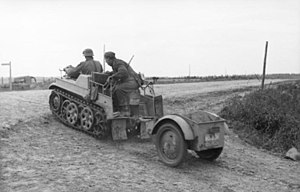Sd.Kfz. 2
| Length: Width: Height: |
3000 mm (118") 1000 mm (39") 1200 mm (47") |
| Engine: | Watercooled four cylinder in-line engine with (OHV), Manufacturer: Opel (GM) |
| Capacity: Bore x Stroke: |
1478 cm³ (taxed) 1488 cm³ (real) 80 mm x 74 mm |
| Compression ratio: | 6:1 |
| Power: | 36 bhp (26 kW) |
| at: | 3400 rpm |
| Top Speed: | 70 km/h (44 mph) |
| Perm. total weight: | 1560 kg (3444 lb) |
| Gearbox: | For. 3 / Rev. 1 speed x 2 range |
| Clutch: | Single plate dry clutch |
| Carburettor: | SOLEX Off-road carburettor type 32 FJ-II |
| Crew: | 3 (Driver + 2 passengers) |
| Tire size: | 3.50-19 |
The SdKfz 2, better known as the Kleines Kettenkraftrad HK 101 or Kettenkrad for short (Ketten = tracks, krad = military abbreviation of the German word Kraftrad, the administrative German term for motorcycle), started its life as a light tractor for airborne troops. The vehicle was designed to be delivered by Junkers Ju 52 aircraft, though not by parachute. The vehicle had the advantage of being the only gun tractor small enough to fit inside the hold of the Ju 52.
Steering the Kettenkrad was accomplished by turning the handlebars: if little movement was used then the wheel would steer the vehicle, however if they were turned further they would engage the track brakes to help make turns sharper.
The SdKfz 2 was designed and built by the NSU Motorenwerke AG at Neckarsulm, Germany. First designed and patented in June 1939, it was first used in the invasion of the Soviet Union in 1941[1]. Later in the war Stoewer from Stettin also produced Kettenkrads under license, accounting for about 10% of the total production.[2]
Most Kettenkrads saw service on the Eastern Front, where they were used to lay communication cables, pull heavy loads and carry soldiers through the deep Russian mud. Late in the war, Kettenkrads were used as runway tugs for aircraft, including jets such as the Me 262. In order to conserve aviation fuel, the aircraft would be towed rather than run the engines while taxiing.
The vehicle was also used in the North African theater and in western Europe.
The Kettenkrad came with a special trailer (Sd.Anh.1) that could be attached to it to improve its cargo capacity.
Being a tracked vehicle the Kettenkrad could climb up to 24° in sand and even more in hard ground, as long as the driver had courage for it.
Only two significant sub-variations of the Kettenkrad were constructed, and production of the vehicle was stopped in 1944, at which time 8,345 had been constructed. After the war the production went on until 1949 for agricultural use.
References
External links
- NSU Kettenkrad Homepage (English language)
- American website relating Kettenkrads. No longer updated
- Kettenkrad Photos of the Kettenkrad at the Canada War Museum in Ottawa
- U.S. Intelligence Report on Kettenkrad
- Walkaround of Kettenkrad at Omaha Beach (France)
- YouTube Video: Kettenkrad driving in heavy mud (Mons, Belgium 2007)



